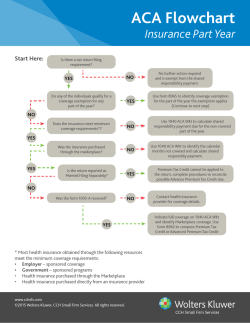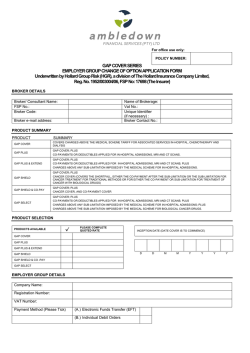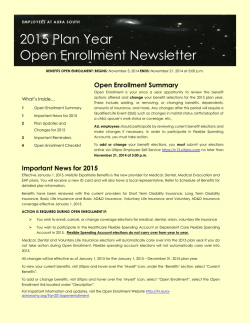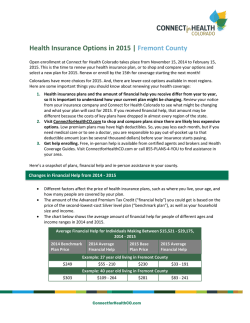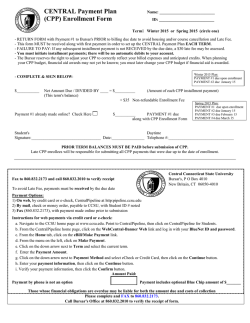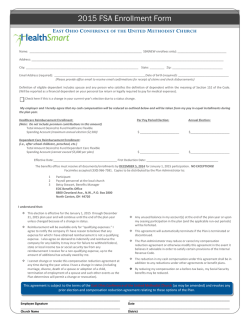
Insurance Brokers and the ACA: Early Barriers and
ACA Implementation—Monitoring and Tracking Insurance Brokers and the ACA: Early Barriers and Options for Expanding Their Role February 2015 Sabrina Corlette, Linda J. Blumberg and Erik Wengle With support from the Robert Wood Johnson Foundation (RWJF), the Urban Institute is undertaking a comprehensive monitoring and tracking project to examine the implementation and effects of the Patient Protection and Affordable Care Act of 2010 (ACA). The project began in May 2011 and will take place over several years. The Urban Institute will document changes to the implementation of national health reform to help states, researchers and policymakers learn from the process as it unfolds. This report is one of a series of papers focusing on particular implementation issues in case study states. Reports that have been prepared as part of this ongoing project can be found at www.rwjf.org and www.healthpolicycenter.org. The quantitative component of the project is producing analyses of the effects of the ACA on coverage, health expenditures, affordability, access and premiums in the states and nationally. For more information about the Robert Wood Johnson Foundation’s work on coverage, visit www.rwjf.org/coverage. INTRODUCTION In-person assistance from navigators and other professionals has significantly facilitated individual and family enrollment into the health insurance marketplaces developed under the Affordable Care Act (ACA).1 However, though enrollment in state and federally facilitated marketplaces was at 6.7 million by late 2014 and has exceeded 9.5 million thus far for 2015,2 millions eligible for financial assistance through the marketplaces remain uninsured. As federal and state funding for navigators and other publicly funded assisters decreases in the coming years,3 private insurance brokers and agents (hereafter referred to collectively as brokers) could play an increasingly important role in expanding coverage to the hard-to-reach uninsured and in ensuring that those already enrolled maintain coverage in the future.4 The ACA’s drafters envisioned a continuing, significant role for brokers in the reformed nongroup insurance markets, but circumstances limited their active participation in the first year of marketplace enrollment. This analysis delineates the early barriers to brokers’ full engagement with the marketplaces, highlights the main concerns with their having a more prominent role and offers options for making them more effective in enrolling the uninsured. The information presented in this brief is based upon interviews conducted with stakeholders (e.g., providers, insurers, consumer advocates, navigators, assisters and brokers) in 21 states and the District of Columbia during the first half of 2014: California, Colorado, Connecticut, District of Columbia, Hawaii, Idaho, Kentucky, Maryland, Massachusetts, Minnesota, Nevada, New Mexico, New York, Oregon, Rhode Island, Vermont and Washington (states using state-based Marketplaces [SBMs]), as well as Arkansas, Delaware, Illinois, New Hampshire and West Virginia (states operating in partnership with the federally facilitated marketplace). BARRIERS TO BROKER ENGAGEMENT IN THE HEALTH INSURANCE MARKETPLACES An Evolving Partnership between Marketplaces and Brokers Most broker respondents reported that the marketplaces did little to engage them or to adopt brokers as part of their marketing and enrollment strategy. The broker community was treated as “an afterthought,” a broker in Washington reported, echoing a common theme, and brokers in Minnesota and New Hampshire sensed that state officials preferred to work with navigators for their outreach and enrollment efforts. Brokers in other states took umbrage at what they saw as the marketplaces’ use of negative language to characterize brokers; a broker in Vermont ACA Implementation—Monitoring and Tracking 2 asserted that the SBM’s ultimate goal was to “eliminate the role of brokers.” Despite inauspicious beginnings in many states, as the 2014 open enrollment period progressed and efforts to enroll people intensified, several marketplaces came to recognize the important role brokers were playing. For example, one broker in Vermont reported that the state formed a broker advisory group “late in the game” after “they realized they needed us.” Other SBMs had no choice but to turn to the broker community after problems with information technology (IT) systems rendered online, unassisted enrollment too difficult. Brokers in Nevada, for example, reported that the marketplace initially rolled out without involving their community. But “now that things aren’t going well,” they said, “the Exchange is advising people to go to brokers.” Oregon also came to rely heavily on brokers for enrollment because of a nonfunctioning IT system. Brokers gave several marketplaces accolades for recognizing that brokers could spread the word about marketplace coverage and help people select a plan. Brokers in California, Connecticut, the District of Columbia, Illinois, New York and Rhode Island reported that the marketplaces made a concerted effort to communicate and work with them over the open enrollment period. In California, the marketplace found that brokers were driving a significant percentage of their non-Medicaid enrollment and became more proactive in their outreach to the broker community. “Fortunately, our partnership has solidified,” one California broker reported, “and Covered California is now seeing the fruits of that [in robust enrollment numbers].” Ultimately, 39 percent of California’s nongroup enrollment into 2014 marketplace plans was broker-assisted.5 Brokers in Rhode Island and the District of Columbia applauded the marketplaces’ efforts to partner with them: of the Rhode Island official responsible for liaising with brokers, they reported that “she has gone above and beyond” in supporting them. Idaho’s marketplace received positive feedback for making it easy for consumers to find available brokers in their area. And brokers applauded marketplace directors in the District of Columbia and California for setting a positive tone and ensuring strong engagement of the broker community. Barriers to Broker Participation in the Marketplaces: Information Technology, Customer Support and Compensation Information Technology Brokers almost universally panned marketplaces’ IT systems. In the same way millions of consumers encountered frustrating glitches with IT systems in many marketplaces, brokers also found the eligibility and enrollment technologies clunky, time consuming, and in some cases impossible to use. In Nevada, for example, brokers had to print out marketplace applications and plan selections and then manually enter them into the insurers’ systems to complete an enrollment. Because brokers are compensated by insurers per enrollee, their profit margins depend on their ability to enroll clients quickly. Yet it took considerably more time to use the marketplace IT systems, even when they functioned properly, than direct enrollment with the insurer. Consequently, many brokers were reluctant to work with subsidy-eligible applicants. One broker said of SBM states: “[Enrollment via the marketplaces] is just very commonly known as a very labor intensive thing—it is not nearly as seamless and simple…as non-[marketplace] plans.” At the same time, brokers in Connecticut, though acknowledging the marketplace application was time-intensive, pointed out that it is less burdensome for consumers than insurers’ pre-ACA applications, which required applicants to complete detailed health questionnaires. The marketplace requirement that assisters, including brokers, provide enrollment assistance solely through face-to-face transactions has also been a sore point for brokers: they feel it inconveniences their clients and significantly adds to the amount of time they are required to spend on each client. Despite early problems, brokers in some states reported dramatic improvements over the course of the open enrollment period. For example, California brokers reported the time to process an application shrank from “up to eight hours” in the first three months to 15 minutes in the latter half of the open enrollment period. Brokers reported, however, that as the marketplaces implemented improvements they often communicated poorly about system changes affecting the eligibility and enrollment processes and work-arounds brokers had become accustomed to using. Brokers reported they would arrive at work and find that the marketplace had deployed new, midstream system changes without any advance notice or training. Customer Support Broker respondents in our study states also panned the marketplace call centers. “The call center has been horrendous,” summarizes the common view. A “useless interaction,” was how another broker characterized his effort to get help through the call center. Brokers reported wait times of 2–3 hours (particularly early in the open enrollment period) and found that call center workers generally lacked training and expertise. Several call centers did not have a dedicated broker call-in line, so brokers were relegated to the general consumer line. As one broker said, “We ACA Implementation—Monitoring and Tracking 3 are calling people who have less knowledge than we do.” Others reported receiving different answers to the same question from different call center workers. In states that do offer a dedicated broker call-in line, such as Kentucky, brokers reported quicker responses but were still frustrated with the lack of expertise. Other states have created dedicated email addresses for brokers, but brokers reported slow response times. In Oregon, brokers reported receiving responses to their emailed questions only 20 percent of the time. Brokers in some states, such as Washington and Vermont, learned that there were some reliable staff within the SBMs they could turn to; brokers praised the assistance those staff are able to provide. Compensation Brokers in almost every state studied viewed the compensation structure as a barrier to assisting consumers with marketplace enrollment. For some, the primary concern was that they were not sufficiently paid for the amount of time it took to help someone through the enrollment process (although the length of time per client did decline as the open enrollment period progressed). “Brokers do double to triple the amount of work for less compensation than [they receive] outside the marketplace,” reported one broker from West Virginia. For others, a major problem was that states do not compensate them for processing Medicaid enrollments. This means brokers often have to choose between turning away low-income people who might be Medicaid-eligible and providing assistance that will ultimately be unpaid. “Brokers might help with short, easy applications, but often direct [likely] Medicaid applicants to enrollment fairs or other assisters,” a broker in Connecticut reported. Brokers also noted that because of problems with the enrollment systems, they are often not credited for assisting a consumer with his or her health plan purchase. In most SBMs, when consumers start an application, they indicate whether a broker is assisting them and provide that broker’s national identification number. In some cases, the marketplace had problems distinguishing between individual brokers and the agencies for which they work. Brokers in Nevada, for example, had trouble figuring out which broker within their agency should have received the commission because only the agency could be listed as the broker of record. Attribution problems were also reported in Colorado. In New York’s open enrollment, consumers who started an application without a broker but sought their assistance later were unable to add the broker’s identification number to their application. Another problem brokers identified was the long lag time between when they assisted a client and when they received payment. Although interviewed several months after the start of open enrollment, brokers in Vermont reported that they had yet to receive any compensation for any marketplace enrollment assistance. “I haven’t received a commission yet, and might not for a few more months,” said one broker. Similarly, Illinois brokers reported that the traditional lag time between assisting a client and getting paid was two months; for one broker waiting on compensation for marketplace plan, however, “it’s going on five months.” Despite these problems, some brokers were able to build a successful business model around nongroup marketplace enrollments. “Brokers need to learn how to turn [marketplace] enrollment into a volume game,” said one broker from Kentucky. He reported generating significant revenue for his agency by targeting small businesses and enrolling their employees in individual marketplace qualified health plans. Brokers in Kentucky drove 44 percent of the marketplace’s enrollment in 2014 nongroup plans.6 CONCERNS OVER GREATER BROKER INVOLVEMENT Though insurance brokers are plentiful throughout the country and do not require public funds for enrolling individuals in nongroup coverage, there are at least two central concerns about using them to expand marketplace enrollment. First, brokers’ financial incentives may not always be aligned with their clients’ best interests. Second, many brokers lack experience working with low-income individuals and families, a group targeted under the ACA for marketplace enrollment and expanded coverage. Potential Conflict of Interest The health insurance marketplaces do not directly compensate brokers; they are compensated by the insurance companies that sell health plans through the marketplaces. Some companies pay brokers a flat amount per enrollee and some pay them a percentage of premiums for the policies they sell. Thus, different companies may compensate the same broker at different levels. Insurance companies may also have higher compensation levels for ACA Implementation—Monitoring and Tracking 4 brokers with a high sales volume, or they may compensate brokers more for selling higher premium plans. Insurers will also typically compensate brokers more for selling to large employer groups than to small groups and individuals. Four SBMs sought to ensure that insurers compensate brokers equally regardless of whether they sell inside or outside the Marketplace.7 But in general, variations in payments by insurer and broker volume can create distinct incentives for the brokers to encourage their clients to purchase particular plans or plans offered by specific insurers. In addition, brokers may have incentives to steer certain types of consumers to off-marketplace plans, particularly if they find the marketplace system to be time consuming and feel they can increase their business volume by avoiding it. Consequently, the plans most valuable for a particular broker to sell may not be the plan best suited for a particular client, creating a conflict of interest. Brokers do not have a legal responsibility to inform clients of the full array of plans available. In fact, brokers frequently do not have appointments with all insurance companies offering coverage through the state’s marketplace, and thus may be unable to receive compensation for selling plans offered by companies with which they are not affiliated. Navigators and in-person assisters are compensated in a substantially different way than are brokers. They are generally paid as hourly or salaried personnel of organizations receiving grants from the marketplace in their state. Consequently, publicly funded assisters do not have a financial interest in which plan an individual or family chooses, and they do not receive different compensation from different insurers. They also do not receive greater compensation for clients who enroll in coverage outside the marketplaces. Lack of Expertise with Low-Income Population Historically, brokers have had minimal experience working with a low-income population. Sources in the industry tell us that before ACA implementation, most low-income individuals who purchased nongroup insurance appeared to enroll without using brokers, who tended to focus on higher-income clients. Brokers may also lack relationships with communities with historically low levels of insurance, such as Hispanic and immigrant populations. Consequently, broker agencies may not have the infrastructure or staff capacity to meet these communities’ linguistic or cultural needs. Conversely, many navigators and in-person assisters have a long history of working with low-income and other underserved populations, for example by helping individuals and families in those communities apply for public assistance programs, such as Medicaid, children’s health insurance, food stamps, or heating assistance. Thus, they may have established relationships within low-income communities and more experience with an income-based government application process. POTENTIAL FOR MORE EFFECTIVELY ENGAGING BROKERS IN MARKETPLACE ENROLLMENT Broker respondents offered several ideas for increasing broker sales of marketplace-based coverage. First, many hope that the marketplaces will be more proactive in giving brokers visibility in their communications and advertising as well as a greater role in marketplace governance and decision-making. In particular, brokers would like to see easy-to-use, online broker directories that enable marketplace shoppers to easily identify a nearby participating broker. Though all SBMs have such directories at this time, their comprehensiveness and ease of use vary. To the extent that a broker facilitates the enrollment process for individuals, easier access to brokers could increase enrollment; however, this is not guaranteed because brokers often sell off-marketplace plans as well and may introduce shoppers to these alternative options. Second, many brokers would like to see improved and ongoing training for enrollment procedures (as opposed to being taught ACA policy details), including hands-on training using individual scenarios and case-based training for complicated circumstances (e.g., immigrants and nontraditional family arrangements). Third, brokers universally agreed that improved IT systems are needed to reduce the time necessary to enroll individuals and families in marketplace plans and effectively engage the broker community in selling these products. Many believed more efficient marketplace IT systems would increase incentives for brokers to sell marketplace plans. However, brokers may want to be careful what they wish for. Improved IT and better plan comparison tools could ACA Implementation—Monitoring and Tracking 5 allow more consumers to self-serve, lessening the need for broker-assisted enrollment. Brokers also would like to see broker-facing portals that include the same functionality they find on insurers’ sites for managing their business. This software allows brokers to track their clients as a group, see when payments are made, send communications to clients, and easily perform customer management tasks. If the marketplaces can integrate these types of case management software into their broker portals, selling marketplace products would become even more attractive to brokers. Fourth, broker communities in several states asked that marketplaces fix several compensation issues. In particular, brokers cited the attribution challenges the marketplaces faced and the need to ensure that brokers are clearly identified on their clients’ applications. If brokers do not trust they will be compensated for the work they perform, they will be less likely to sell marketplace products. In addition, if states begin to compensate brokers for enrolling lowincome individuals and families in Medicaid, they may be able to improve the share of eligible individuals enrolling in public coverage. However, token payments alone are unlikely to entice brokers. Absent such payments, state and federal marketplaces can strongly encourage and even foster explicit partnerships between navigators and brokers, so that potential Medicaid enrollees and private purchasers with complex insurance needs can be best served without falling through the enrollment cracks after contact with one or the other type of assister. In some states, such partnerships have been discouraged. Federal regulators have said, however, that they will provide guidance on navigator-broker partnerships in the near future because of confusion over how much the two types of assisters can work together to enroll people through the federally facilitated marketplaces. Fifth, state marketplaces that have hired brokers to work on staff have found that having those placements can significantly improve communication with the broker community and speed the resolution of problems hampering their ability to enroll clients in the plans. Finally, marketplaces could do more to monitor broker participation to better understand whether and how they are facilitating enrollment. Many sources feel that regular surveys of brokers selling marketplace plans could be an effective way of providing feedback and informing state and federal governments of problems and barriers to increased participation. Others suggested that tracking broker volume of sales, the distribution of plans being sold by each broker and the characteristics of brokers’ clients could provide important information for the marketplaces. For example, if individual brokers tend to sell a small number of plans or only plans offered by a single insurer, this could indicate either the need to increase awareness and understanding of broader marketplace options or strong financial incentives from a particular insurer and the possibility of a conflict of interest. If brokers tend to sell bronze plans as opposed to silver plans to subsidy-eligible enrollees, additional training on the value of available costsharing reductions (only available through silver plans) may be needed. If broker-mediated marketplace enrollments tend to skew toward older or less healthy individuals, this could signal adverse selection concerns. CONCLUSION Over time, marketplaces are unlikely to sustain the same levels of funding to support in-person enrollment assistance as they had during the initial rollout. Consequently, many may seek to leverage insurance brokers to conduct consumer education and help people enroll in marketplace plans. As evidenced here, sources interviewed have many concrete suggestions for increasing broker sales of marketplace plans, potentially increasing enrollment under the ACA. The amount that increased broker sales can reduce the number of uninsured, however, would be a function of whether brokers enroll more individuals previously uninsured or remain focused on those who previously had coverage through another source (e.g., the off-marketplace nongroup market). Though increasing the size of the marketplaces is valuable for its own reasons (e.g., because it increases the base for financing the marketplace’s administrative costs and potentially attracts more insurers to participate) ultimately, two of the ACA’s primary objectives are to reduce the number of uninsured and increase affordable access to medical care regardless of health status or other characteristics. Achieving those objectives will require brokers to expand their reach into new populations and continue to provide effective counsel to their clients on the types of plans and plan structures (e.g., deductibles, co-payments, co-insurance, out-of-pocket maximums, benefits, provider networks) that will best meet their financial and medical care needs. ACA Implementation—Monitoring and Tracking 6 ENDNOTES 1. Dorn, S. Public Education, Outreach, and Enrollment Assistance. Washington: Urban Institute, 2014, http://www.urban.org/publications/2000037.html (accessed January 2015). 2. US Department of Health and Human Services, “Health Insurance Marketplace 2015 Open Enrollment Period: January Enrollment Report.” Washington: Office of the Assistant Secretary for Planning and Evaluation, 2015, http://aspe.hhs.gov/health/reports/2015/MarketPlaceEnrollment/Jan2015/ ib_2015jan_enrollment.pdf (accessed January 2015). 3. Volk J, Corlette S, Ahn S and Brooks T. Report From the First Year of Navigator Technical Assistance Project: Lessons Learned and Recommendations for the Next Year of Enrollment. Washington: Center on Health Insurance Reforms, Georgetown University, 2014, http://www.rwjf.org/content/dam/farm/reports/issue_briefs/2014/ rwjf416166 (accessed January 2015). 4. Kingsdale J, Mazza K and Connolly K. “Boosting Enrollment: Lessons Learned From 2013–2014.” Princeton, NJ: Robert Wood Johnson Foundation, 2014, http://www.statenetwork.org/wp-content/uploads/2014/08/State-Network-WakelyBoosting-Enrollment-August-2014.pdf (accessed January 2015). 5. Gold J, “Insurance Brokers Key to Kentucky’s Obamacare Success,” NPR, Tuesday, September 23, 2014, http://www.npr.org/blogs/health/2014/09/23/ 348713580/insurance-brokers-key-to-kentucky-s-obamacare-success (accessed January 2015). 6. ibid. 7. Blumberg LJ, Rifkin S, Corlette S and Dash SJ. “Stabilizing Premiums Under the Affordable Care Act: State Efforts to Reduce Adverse Selection.” Washington: Urban Institute, 2013, http://www.rwjf.org/content/dam/farm/reports/reports/ 2013/rwjf408881 (accessed January 2015). Copyright© February 2015. The Urban Institute. Permission is granted for reproduction of this file, with attribution to the Urban Institute. About the Authors and Acknowledgements Sabrina Corlette is a senior research fellow at Georgetown University’s Center on Health Insurance Reforms. Linda Blumberg is a senior fellow and Erik Wengle is a research assistant in the Urban Institute’s Health Policy Center. The authors are grateful to John Holahan, Kevin Lucia, Sandy Ahn and Tricia Brooks for their review and comments. We also thank Mason Weber for his research support. About the Robert Wood Johnson Foundation For more than 40 years the Robert Wood Johnson Foundation has worked to improve health and health care. We are striving to build a national Culture of Health that will enable all to live longer, healthier lives now and for generations to come. For more information, visit www.rwjf.org. Follow the Foundation on Twitter at www.rwjf.org/twitter or on Facebook at www.rwjf.org/facebook. About the Urban Institute The Urban Institute is a nonprofit, nonpartisan policy research and educational organization that examines the social, economic and governance problems facing the nation. For more information, visit www.urban.org. Follow the Urban Institute on Twitter www.urban.org/twitter or Facebook www.urban.org/facebook. More information specific to the Urban Institute’s Health Policy Center, its staff, and its recent research can be found at www.healthpolicycenter.org. About Georgetown University’s Center on Health Insurance Reforms The Center on Health Insurance Reforms at Georgetown University’s Health Policy Institute is a nonpartisan, expert team of faculty and staff dedicated to conducting research on the complex and developing relationship between state and federal oversight of health insurance markets. For more information visit chir.georgetown.edu. ACA Implementation—Monitoring and Tracking 7
© Copyright 2025
